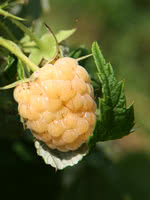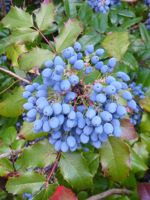Mon-Fri 9am - 5pm Mountain time
Honey Queen Raspberry vs Oregon Grape
Rubus x Honey Queen
Mahonia aquifolium (Berberis aquifolium)
NOT AVAILABLE THIS SEASON - MIGHT RETURN
Honey Queen Raspberry is known for its sweet honey flavor and unique yellow color. Its berries are soft and medium-sized, nice for picking and eating in the summer.
Honey Queen was developed in Rocky Mountain House by Robert Erskine and is very winter hardy. Canes are yellowish, floricane, arched and moderately spiny.
Honey Queen should be trellised upright for best results. While all raspberries prefer the sun, Honey Queen is the best option for planting in shady areas.
The Honey Queen Raspberry is a fast-growing floricane. This means that raspberries will not grow on canes the year they first grow. The mature canes they do grow on, however, produce more berries than primocane varieties.
Check out some video of a Honey Queen Raspberry we saw this summer on our YouTube Channel. Click here.
Oregon Grape is an evergreen shrub native to North America, found along the Pacific coast. In spring, the bright golden-yellow flowers appear in clusters above the leaves. These flowers eventually give way to edible blue berries in late summer. While not a true grape, the berries appear grape-like due to their colouring and clustered growth. They can be eaten fresh, but the sour taste and high amounts of natural pectin make them well suited for preserves.
The Oregon Grape has leaves that are glossy, leathery, and spiny-edged. This feature gives it its alternate name of Holly-leaved Barberry. When the leaves emerge in the spring they are a bronze-red colour. In the summer they transition to green, followed by bright red to deep burgundy in the fall. Leaves are retained throughout the winter and colder temperatures cause the leaves to turn purplish bronze, providing year round interest to the landscape.

